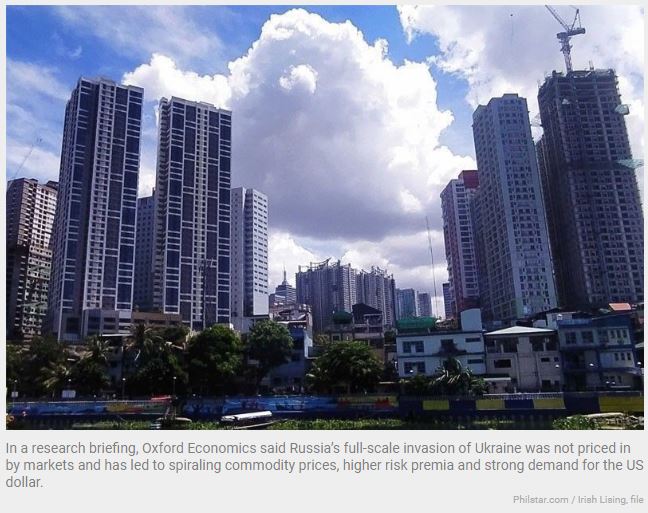Philippines: Downside risk seen due to high commodity prices
MANILA, Philippines — The downside risks of increasing commodity prices, caused by Russia’s invasion of Ukraine, on Asia-Pacific currencies are seen to be the strongest in the Philippines and India as they are net commodity importers, according to Oxford Economics.
In a research briefing, Oxford Economics said Russia’s full-scale invasion of Ukraine was not priced in by markets and has led to spiraling commodity prices, higher risk premia and strong demand for the US dollar.
“Asian foreign exchange (FX) markets have felt the combined impact of these developments. Since the start of the Russia-Ukraine war, currencies of commodity importers have underperformed, with the INR (Indian rupee), KRW (Korean won), PHP (Philippine peso) and THB (Thailand baht) weakening around two percent against the USD,” Oxford said.
“We expect these trends to spill over into the second quarter, with currencies that are more vulnerable to rising commodity prices continuing to underperform,” it said.
Oxford Economics emphasized, however, that once market volatility subsides and the gentle weakening of the US dollar resumes, it expects the divergence to narrow and for most currencies to end the year stronger, supported by positive real long-term government bond yields, resilient external positions and supportive valuations.
“Current volatility may last longer than our baseline assumption of six months and we think risks are weighted to the downside. In a plausible downside scenario, the USD will remain stronger well into 2023,”Oxford Economics said.
“In our view, downside risks are strongest for historically ‘twin deficit’ countries that are also net commodity importers in the region, namely India and the Philippines,” it said.
Oxford Economics said the sharp equity outflows and a spike in risk premium in recent weeks for India point to rapidly weakening investor sentiment.
“From a policy perspective, higher inflation and deteriorating deficits will increase the pressure on the RBI (Reserve Bank of India) and the BSP (Bangko Sentral ng Pilipinas) to act more aggressively. But slowing growth is making them drag their feet on policy normalization,” Oxford Economics said.
“How they navigate this policy dilemma will have implications for their FX trajectory once the dust settles,” it said.
Oxford Economics said Asia’s weak economic and financial links with Russia and Ukraine mean that it’s not as exposed as Europe and the US.
“But Asia won’t be insulated from global developments, which will infiltrate through rising commodity prices and lower foreign demand,” it said.
In line with this, Oxford Economics raised its forecast for Asia’s CPI inflation for 2022 to 3.3 percent, 0.3 ppts higher than its no-conflict baseline.
It also revised downward its forecast for Gross Domestic Product (GDP) growth for 2022 by 0.2 ppts to five percent, and made substantial revisions to its current account projections.
“The impacts will vary across the region and be more nuanced than the aggregate picture suggests,” Oxford Economics said.
Oxford Economics said it revised its baseline forecasts to incorporate the most likely macroeconomic effects of the Russia-Ukraine war. It explained that the new baseline integrates higher energy, food, and other commodity prices over the medium term, more financial market disruption, and tougher EU and US sanctions on Russia.
Source: https://www.philstar.com/business/2022/03/15/2167255/downside-risk-seen-due-high-commodity-prices


 Thailand
Thailand




